Around the World
January/February 2020
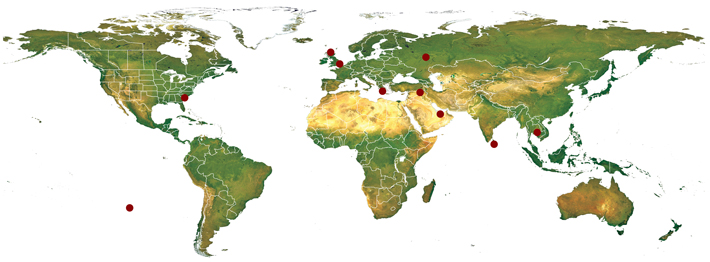

-
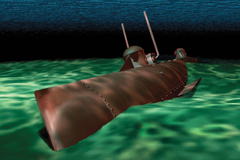 SOUTH CAROLINA: After the Confederate submarine Hunley attacked USS Housatonic in 1864, the sub sank mysteriously, killing all eight of its crew. Experts have long wondered why the vessel went down, and some now believe it may have been due to a disabled air circulation system. New research suggests that the system of snorkel tubes and rubber hoses that pumped fresh air into the vessel while it remained submerged had been dismantled, perhaps contributing to the sub’s fate.
SOUTH CAROLINA: After the Confederate submarine Hunley attacked USS Housatonic in 1864, the sub sank mysteriously, killing all eight of its crew. Experts have long wondered why the vessel went down, and some now believe it may have been due to a disabled air circulation system. New research suggests that the system of snorkel tubes and rubber hoses that pumped fresh air into the vessel while it remained submerged had been dismantled, perhaps contributing to the sub’s fate. -
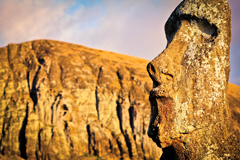 CHILE: The enormous carved heads known as moai are the most recognizable monuments created by the Polynesian civilization that settled Rapa Nui (Easter Island) around A.D. 1000. It turns out the sculptures were also instrumental in boosting agricultural productivity there. Analysis of soil samples taken near the island’s main quarry indicates that quarrying activity caused phosphorous and other beneficial substances to enrich the adjacent slopes. This allowed the Rapa Nui settlers to grow sweet potatoes, bananas, and taro there, even when conditions were less favorable elsewhere on the island.
CHILE: The enormous carved heads known as moai are the most recognizable monuments created by the Polynesian civilization that settled Rapa Nui (Easter Island) around A.D. 1000. It turns out the sculptures were also instrumental in boosting agricultural productivity there. Analysis of soil samples taken near the island’s main quarry indicates that quarrying activity caused phosphorous and other beneficial substances to enrich the adjacent slopes. This allowed the Rapa Nui settlers to grow sweet potatoes, bananas, and taro there, even when conditions were less favorable elsewhere on the island. -
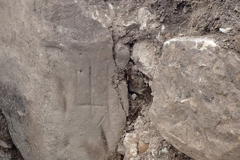 SCOTLAND: In the 18th and early 19th centuries, a well-traveled drover’s road made the Wilkhouse Inn near Brora a hive of activity. Archaeologists have uncovered a trove of objects, including glass fragments, coins, and personal items left behind by the tavern’s guests in its heyday. But not everyone was welcome at the inn. An inverted cross carved into a fireplace hearthstone was intended to deter witches from flying down the chimney.
SCOTLAND: In the 18th and early 19th centuries, a well-traveled drover’s road made the Wilkhouse Inn near Brora a hive of activity. Archaeologists have uncovered a trove of objects, including glass fragments, coins, and personal items left behind by the tavern’s guests in its heyday. But not everyone was welcome at the inn. An inverted cross carved into a fireplace hearthstone was intended to deter witches from flying down the chimney. -
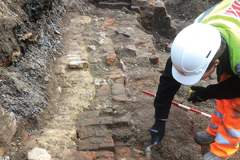 ENGLAND: Parts of a Shakespeare-era theater were unearthed under London’s Whitechapel neighborhood. The Boar’s Head Playhouse is known from historical documents, but its ruins were brought to light for the first time during a recent construction project. Originally an inn, the Boar’s Head was converted to a theater in 1598. However, records show that open-air performances were held on the property as early as 1557, when a play titled A Sack Full of News was banned due to its lewdness.
ENGLAND: Parts of a Shakespeare-era theater were unearthed under London’s Whitechapel neighborhood. The Boar’s Head Playhouse is known from historical documents, but its ruins were brought to light for the first time during a recent construction project. Originally an inn, the Boar’s Head was converted to a theater in 1598. However, records show that open-air performances were held on the property as early as 1557, when a play titled A Sack Full of News was banned due to its lewdness. -
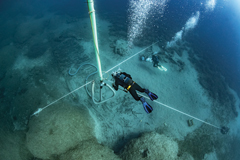 GREECE: In 1802, the ship Mentor was sailing to England when it sank off the island of Kythira. Seventeen boxes of ancient treasures, including the famous Parthenon Marbles, went down to the seafloor. Most of the precious objects were quickly raised, but investigation of the wreck site has shown that many remained. Divers recently retrieved a gold ring, a pair of gold earrings, and three gaming pieces, as well as various other wood, ceramic, and bone artifacts.
GREECE: In 1802, the ship Mentor was sailing to England when it sank off the island of Kythira. Seventeen boxes of ancient treasures, including the famous Parthenon Marbles, went down to the seafloor. Most of the precious objects were quickly raised, but investigation of the wreck site has shown that many remained. Divers recently retrieved a gold ring, a pair of gold earrings, and three gaming pieces, as well as various other wood, ceramic, and bone artifacts. -
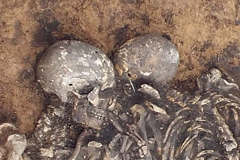 RUSSIA: Between the 14th and 18th centuries, the Black Death killed as much as 60 percent of Europe’s population. The bacterium that caused the plague has now been traced to the town of Laishevo, near the Volga River. Scientists reconstructed the bacterium’s genome by taking samples from the teeth of 34 victims buried at 10 different sites. They concluded that the sample from Laishevo was ancestral to the others, indicating that the plague must have originally struck there before spreading westward.
RUSSIA: Between the 14th and 18th centuries, the Black Death killed as much as 60 percent of Europe’s population. The bacterium that caused the plague has now been traced to the town of Laishevo, near the Volga River. Scientists reconstructed the bacterium’s genome by taking samples from the teeth of 34 victims buried at 10 different sites. They concluded that the sample from Laishevo was ancestral to the others, indicating that the plague must have originally struck there before spreading westward. -
 IRAQ: Assyrian astronomers gazing at the sky almost 2,700 years ago were the first people to document the colorful cosmic phenomena known as auroras. These light shows, known in the Northern Hemisphere as the northern lights, appear when waves of charged particles from the sun collide with the earth’s magnetic field. When a massive solar wave hit the earth in the early 7th century B.C., the effects were visible as far south as Mesopotamia. Three cuneiform tablets from Nineveh record this unusual event, documenting a strange “red glow,” “red cloud,” and “red sky.”
IRAQ: Assyrian astronomers gazing at the sky almost 2,700 years ago were the first people to document the colorful cosmic phenomena known as auroras. These light shows, known in the Northern Hemisphere as the northern lights, appear when waves of charged particles from the sun collide with the earth’s magnetic field. When a massive solar wave hit the earth in the early 7th century B.C., the effects were visible as far south as Mesopotamia. Three cuneiform tablets from Nineveh record this unusual event, documenting a strange “red glow,” “red cloud,” and “red sky.” -
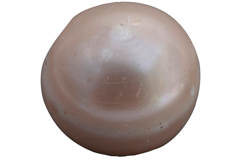 UNITED ARAB EMIRATES: A wealth of biological material from two islands in the Persian Gulf demonstrates how well Neolithic communities exploited marine resources. For example, thousands of fish bones from the islands of Marawah and Dalma indicate that people living there 7,500 years ago used nets and traps made from date palms to catch a wide variety of fish. On Marawah, archaeologists also discovered the world’s oldest known pearl, a rare item that would have been used as either jewelry or currency.
UNITED ARAB EMIRATES: A wealth of biological material from two islands in the Persian Gulf demonstrates how well Neolithic communities exploited marine resources. For example, thousands of fish bones from the islands of Marawah and Dalma indicate that people living there 7,500 years ago used nets and traps made from date palms to catch a wide variety of fish. On Marawah, archaeologists also discovered the world’s oldest known pearl, a rare item that would have been used as either jewelry or currency. -
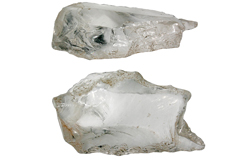 SRI LANKA: It was much harder for early humans to fashion small, delicate stone tools such as arrowheads than it was to make large, substantial ones like axes. Yet, by around 45,000 years ago, a community living in the rain forests of Sri Lanka had mastered this technology. A collection of microliths found in the Fa-Hien Lena Cave is the oldest assemblage ever discovered in South Asia. These advanced tools allowed people to thrive in the area’s difficult rainforest environment earlier than was once thought, by hunting small tree-dwelling animals.
SRI LANKA: It was much harder for early humans to fashion small, delicate stone tools such as arrowheads than it was to make large, substantial ones like axes. Yet, by around 45,000 years ago, a community living in the rain forests of Sri Lanka had mastered this technology. A collection of microliths found in the Fa-Hien Lena Cave is the oldest assemblage ever discovered in South Asia. These advanced tools allowed people to thrive in the area’s difficult rainforest environment earlier than was once thought, by hunting small tree-dwelling animals. -
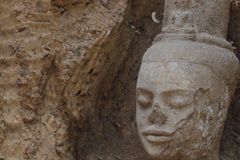 CAMBODIA: Workers searching through a pile of debris for fallen roof stones from the Ta Nei Temple in Angkor unexpectedly unearthed the head of an ancient bodhisattva statue. The sculpture, which is around 2 feet tall and dates to the late 12th or early 13th century, has a small Buddha figure carved into the hair above its forehead. In Mahayana Buddhism, a bodhisattva is someone who is on the path of enlightenment to attain Buddhahood.
CAMBODIA: Workers searching through a pile of debris for fallen roof stones from the Ta Nei Temple in Angkor unexpectedly unearthed the head of an ancient bodhisattva statue. The sculpture, which is around 2 feet tall and dates to the late 12th or early 13th century, has a small Buddha figure carved into the hair above its forehead. In Mahayana Buddhism, a bodhisattva is someone who is on the path of enlightenment to attain Buddhahood.
Advertisement
IN THIS ISSUE
Digs & Discoveries
The Man in Prague Castle
Off the Grid
As Told by Herodotus
Bath Buddy
Maya Maize God's Birth
Cretan Coastal Rites
Still Standing
Deerly Departed
The Time Had Come, the Walrus Said
Skoal!
Maya Total War
A Seaside Journey to America
City Limits
Where's the Beef?
Around the World
Rapa Nui moai farmers, the world’s oldest pearl, a rowdy Scottish tavern, and what ancient Assyrian stargazers saw
Artifact
The formula for success
Advertisement

Recent Issues
-
 May/June 2024
May/June 2024
-
 March/April 2024
March/April 2024
-
 January/February 2024
January/February 2024
-
 November/December 2023
November/December 2023
-
 September/October 2023
September/October 2023
-
 July/August 2023
July/August 2023
-
 May/June 2023
May/June 2023
-
 March/April 2023
March/April 2023
-
 January/February 2023
January/February 2023
-
 November/December 2022
November/December 2022
-
 September/October 2022
September/October 2022
-
 July/August 2022
July/August 2022
-
 May/June 2022
May/June 2022
-
 March/April 2022
March/April 2022
-
 January/February 2022
January/February 2022
-
 November/December 2021
November/December 2021
-
 September/October 2021
September/October 2021
-
 July/August 2021
July/August 2021
-
 May/June 2021
May/June 2021
-
 March/April 2021
March/April 2021
-
 January/February 2021
January/February 2021
-
 November/December 2020
November/December 2020
-
 September/October 2020
September/October 2020
-
 July/August 2020
July/August 2020
-
 May/June 2020
May/June 2020
-
 March/April 2020
March/April 2020
-
 January/February 2020
January/February 2020
-
 November/December 2019
November/December 2019
-
 September/October 2019
September/October 2019
-
 July/August 2019
July/August 2019
-
 May/June 2019
May/June 2019
-
 March/April 2019
March/April 2019
-
 January/February 2019
January/February 2019
-
 November/December 2018
November/December 2018
-
 September/October 2018
September/October 2018
-
 July/August 2018
July/August 2018
-
 May/June 2018
May/June 2018
-
 March/April 2018
March/April 2018
-
 January/February 2018
January/February 2018
-
 November/December 2017
November/December 2017
-
 September/October 2017
September/October 2017
-
 July/August 2017
July/August 2017
-
 May/June 2017
May/June 2017
-
 March/April 2017
March/April 2017
-
 January/February 2017
January/February 2017
-
 November/December 2016
November/December 2016
-
 September/October 2016
September/October 2016
-
 July/August 2016
July/August 2016
-
 May/June 2016
May/June 2016
-
 March/April 2016
March/April 2016
-
 January/February 2016
January/February 2016
-
 November/December 2015
November/December 2015
-
 September/October 2015
September/October 2015
-
 July/August 2015
July/August 2015
-
 May/June 2015
May/June 2015
-
 March/April 2015
March/April 2015
-
 January/February 2015
January/February 2015
-
 November/December 2014
November/December 2014
-
 September/October 2014
September/October 2014
-
 July/August 2014
July/August 2014
-
 May/June 2014
May/June 2014
-
 March/April 2014
March/April 2014
-
 January/February 2014
January/February 2014
-
 November/December 2013
November/December 2013
-
 September/October 2013
September/October 2013
-
 July/August 2013
July/August 2013
-
 May/June 2013
May/June 2013
-
 March/April 2013
March/April 2013
-
 January/February 2013
January/February 2013
-
 November/December 2012
November/December 2012
-
 Sep/Oct 2012
Sep/Oct 2012
-
 September/October 2012
September/October 2012
-
 July/August 2012
July/August 2012
-
 May/June 2012
May/June 2012
-
 March/April 2012
March/April 2012
-
 January/February 2012
January/February 2012
-
 November/December 2011
November/December 2011
-
 September/October 2011
September/October 2011
-
 July/August 2011
July/August 2011
-
 May/June 2011
May/June 2011
-
 March/April 2011
March/April 2011
-
 January/February 2011
January/February 2011
Advertisement






